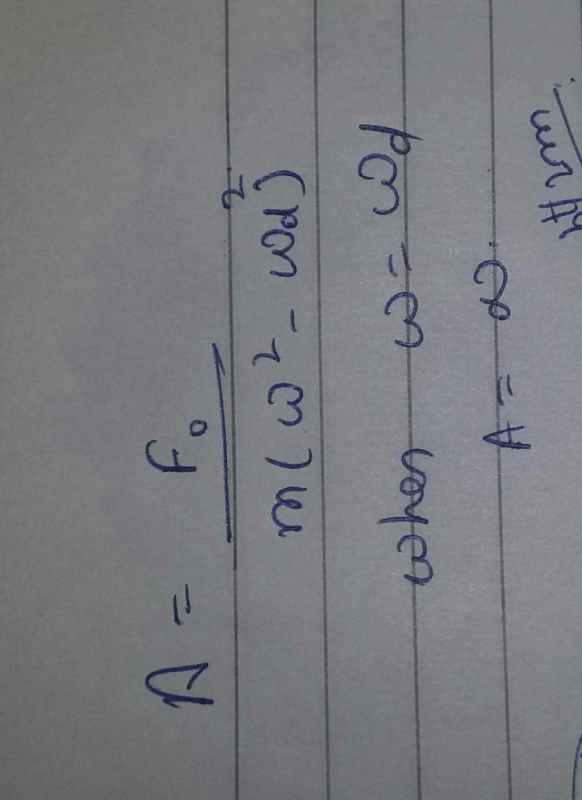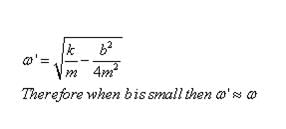All Exams >
EmSAT Achieve >
Physics for EmSAT Achieve >
All Questions
All questions of Damped Oscillations for EmSAT Achieve Exam
What determines the natural frequency of a body?- a)Position of the body with respect to force applied
- b)Mass and speed of the body
- c)Oscillations in the body
- d)Elastic properties and dimensions of the body
Correct answer is option 'D'. Can you explain this answer?
What determines the natural frequency of a body?
a)
Position of the body with respect to force applied
b)
Mass and speed of the body
c)
Oscillations in the body
d)
Elastic properties and dimensions of the body
|
|
Lavanya Menon answered |
Natural frequency is the frequency at which a body tends to oscillate in the absence of any driving or damping force.
Free vibrations of any elastic body are called natural vibration and happen at a frequency called natural frequency. Natural vibrations are different from forced vibration which happen at frequency of applied force .
Free vibrations of any elastic body are called natural vibration and happen at a frequency called natural frequency. Natural vibrations are different from forced vibration which happen at frequency of applied force .
If  is the natural frequency of the system and
is the natural frequency of the system and  is the frequency of the external force that acts on an oscillating system then at resonance
is the frequency of the external force that acts on an oscillating system then at resonance- a)ωd ≥ ω
- b)ωd = ω
- c)ωd ≤ ω
- d)ωd ≠ ω
Correct answer is option 'B'. Can you explain this answer?
If  is the natural frequency of the system and
is the natural frequency of the system and  is the frequency of the external force that acts on an oscillating system then at resonance
is the frequency of the external force that acts on an oscillating system then at resonance
 is the natural frequency of the system and
is the natural frequency of the system and  is the frequency of the external force that acts on an oscillating system then at resonance
is the frequency of the external force that acts on an oscillating system then at resonancea)
ωd ≥ ω
b)
ωd = ω
c)
ωd ≤ ω
d)
ωd ≠ ω
|
|
Om Desai answered |
When the natural frequency and external frequency of an object are equal the phenomenon is called resonance.
The restoring force in a simple harmonic motion is _________ in magnitude when the particle is instantaneously at rest.- a)zero
- b)maximum
- c)minimum
- d)none of these
Correct answer is option 'B'. Can you explain this answer?
The restoring force in a simple harmonic motion is _________ in magnitude when the particle is instantaneously at rest.
a)
zero
b)
maximum
c)
minimum
d)
none of these

|
Knowledge Hub answered |
The restoring force in a simple harmonic motion is maximum in magnitude when the particle is instantaneously at rest because in SHM object’s tendency is to return to mean position and here particle is instantaneously at rest after that instant restoring force will be max to bring particle to mean position.
If an external force with angular frequency ωd acts on an oscillating system with natural angular frequency ω, the system oscillates with angular frequency ωd. The amplitude of oscillations is the greatest when:- a)ωd > ω
- b)ωd < ω
- c)ωd ≥ ω
- d)ωd = ω
Correct answer is option 'D'. Can you explain this answer?
If an external force with angular frequency ωd acts on an oscillating system with natural angular frequency ω, the system oscillates with angular frequency ωd. The amplitude of oscillations is the greatest when:
a)
ωd > ω
b)
ωd < ω
c)
ωd ≥ ω
d)
ωd = ω
|
|
Jyoti Aiims Aspirant answered |

Under what condition angular frequency ω of the damped oscillator would be equivalent to angular velocity Ω of the undamped oscillator.- a)Velocity of oscillator is small
- b)Damping constant, b is small
- c)Damping constant ,b is large
- d)Force applied is small
Correct answer is option 'B'. Can you explain this answer?
Under what condition angular frequency ω of the damped oscillator would be equivalent to angular velocity Ω of the undamped oscillator.
a)
Velocity of oscillator is small
b)
Damping constant, b is small
c)
Damping constant ,b is large
d)
Force applied is small
|
|
Priya Patel answered |

The amplitude of S.H.M at resonance is _______ in the ideal case of zero damping.- a)Maximum
- b)Minimum
- c)Zero
- d)Infinite
Correct answer is option 'D'. Can you explain this answer?
The amplitude of S.H.M at resonance is _______ in the ideal case of zero damping.
a)
Maximum
b)
Minimum
c)
Zero
d)
Infinite
|
|
Neha Joshi answered |
In an ideal environment where there is no resistance to oscillation motion i.e. damping is zero, when we oscillate a system at its resonant frequency since there is no opposition to oscillation, the amplitude will go on increasing and reach infinity.
In the ideal case of zero damping, the amplitude of simple harmonic motion at resonance is:- a)zero
- b)infinite
- c)cannot be said
- d)varies from zero to infinite
Correct answer is option 'B'. Can you explain this answer?
In the ideal case of zero damping, the amplitude of simple harmonic motion at resonance is:
a)
zero
b)
infinite
c)
cannot be said
d)
varies from zero to infinite
|
|
Priya Patel answered |
In an ideal environment where there is no resistance to oscillatory motion, that is, damping is zero, when we oscillate a system at its resonant frequency, since there is no opposition to oscillation, a very large value of amplitude will be recorded. Forced oscillation is when you apply an external oscillating force.
The phenomenon of increase in amplitude when the driving force is close to the natural frequency of the oscillator is known as- a)Accelerated Amplitude
- b)Epoch
- c)Resonance
- d)Dampening
Correct answer is option 'C'. Can you explain this answer?
The phenomenon of increase in amplitude when the driving force is close to the natural frequency of the oscillator is known as
a)
Accelerated Amplitude
b)
Epoch
c)
Resonance
d)
Dampening
|
|
Priya Patel answered |
The phenomenon of increase in amplitude when the driving force is close to the natural frequency of the oscillator is known as. The phenomenon of increase in amplitude when the driving force is close to the natural frequency of the oscillator is known as resonance.
Under forced oscillation, the phase of the harmonic motion of the particle and phase of driving force- a)Are same
- b)Are different
- c)Both are zero
- d)Not present
Correct answer is option 'B'. Can you explain this answer?
Under forced oscillation, the phase of the harmonic motion of the particle and phase of driving force
a)
Are same
b)
Are different
c)
Both are zero
d)
Not present
|
|
Pratibha Sharma answered |
Harmonic motion is the natural motion of a body(we consider no air friction) under no force where as damped oscillation are under force hence the iscilation are different
Energy is supplied to the damped oscillatory system at the same rate at which it is dissipating energy, then the amplitude of such oscillations would become constant. Such oscillations are called- a)Damped oscillations
- b)Undamped oscillations
- c)Coupled oscillations
- d)Maintained oscillations
Correct answer is option 'D'. Can you explain this answer?
Energy is supplied to the damped oscillatory system at the same rate at which it is dissipating energy, then the amplitude of such oscillations would become constant. Such oscillations are called
a)
Damped oscillations
b)
Undamped oscillations
c)
Coupled oscillations
d)
Maintained oscillations
|
|
Anoushka Basu answered |
Energy is supplied to the damped oscillatory system at the same rate at which it is dissipating energy, and then the amplitude of such oscillations would become constant. Such oscillations are called maintained oscillations. By the definition of maintained oscillations.
Chapter doubts & questions for Damped Oscillations - Physics for EmSAT Achieve 2025 is part of EmSAT Achieve exam preparation. The chapters have been prepared according to the EmSAT Achieve exam syllabus. The Chapter doubts & questions, notes, tests & MCQs are made for EmSAT Achieve 2025 Exam. Find important definitions, questions, notes, meanings, examples, exercises, MCQs and online tests here.
Chapter doubts & questions of Damped Oscillations - Physics for EmSAT Achieve in English & Hindi are available as part of EmSAT Achieve exam.
Download more important topics, notes, lectures and mock test series for EmSAT Achieve Exam by signing up for free.
Physics for EmSAT Achieve
208 videos|329 docs|212 tests
|

Contact Support
Our team is online on weekdays between 10 AM - 7 PM
Typical reply within 3 hours
|
Free Exam Preparation
at your Fingertips!
Access Free Study Material - Test Series, Structured Courses, Free Videos & Study Notes and Prepare for Your Exam With Ease

 Join the 10M+ students on EduRev
Join the 10M+ students on EduRev
|

|
Create your account for free
OR
Forgot Password
OR
Signup on EduRev and stay on top of your study goals
10M+ students crushing their study goals daily









